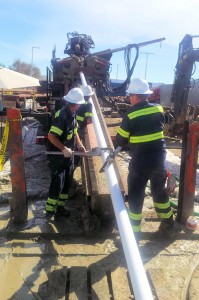UPDATE: Record-setting 1,500′ Long Sparge Well, 130′ deep
In October, DTD completed the installation of a blind air sparge well, with almost 700′ of horizontal sparge screen set at a depth of 130′ below a Los Angeles manufacturing facility. The well’s total length is 1,470′ This may be the longest single-ended environmental remediation well yet installed in the United States. UPDATE: The second well, over 1,500 feet in length, was completed on October 22.
Sparge wells (and remediation wells in general) can be of nearly infinite configurations, with many of the wells being less than 200′ long and suited for small gas station or dry cleaner sites. However, for this particular site, the opposite was necessary.
At this Los Angeles site, ground- water contamination has migrated beneath the footprint of manufacturing building nearly four acres in extent. The manufacturing activities in the building are operated by a third party, and to complicate the issuee, the depth to groundwater is almost 100′ below ground. Since drilling through the floor of the manufacturing facility to install a network of vertical wells was not allowed by the owner, a system of two horizontal wells was designed to cover the treatment zone.
The length of the wells and the site geology (loose sands) prevented the blind installation in a traditional manner, so DTD brought its patent-pending Knock Off Drill Bit assembly to the site. This allows 4″ well materials to be installed through the drill rod to the drill bit. The sacrificial bit is engaged by the well materials, and releases from the drill rod…. and the rod is then stripped back out of the borehole. This method allows guaranteed installation to the position of the drill bit. It also allows plastic well materials to be installed without the risk of breaking them. Something that is otherwise impossible in long blind wells.
Due to the depth and surface inaccessibility to the bore path, DTD elected to use a Gyroscopic Steering Tool (GST) for locating and steering along the compound bore paths for these wells. The GST may be operated without any surface access, to depths that far exceed the capabilities of walkover locating systems. After drilling the pilot bores with the GST, the tooling was removed from the bore and the Knock-Off assembly was then pushed in, spot checking with a walkover tool while it was within range, to assure that the Knock-Off tooling followed the pilot bore.
